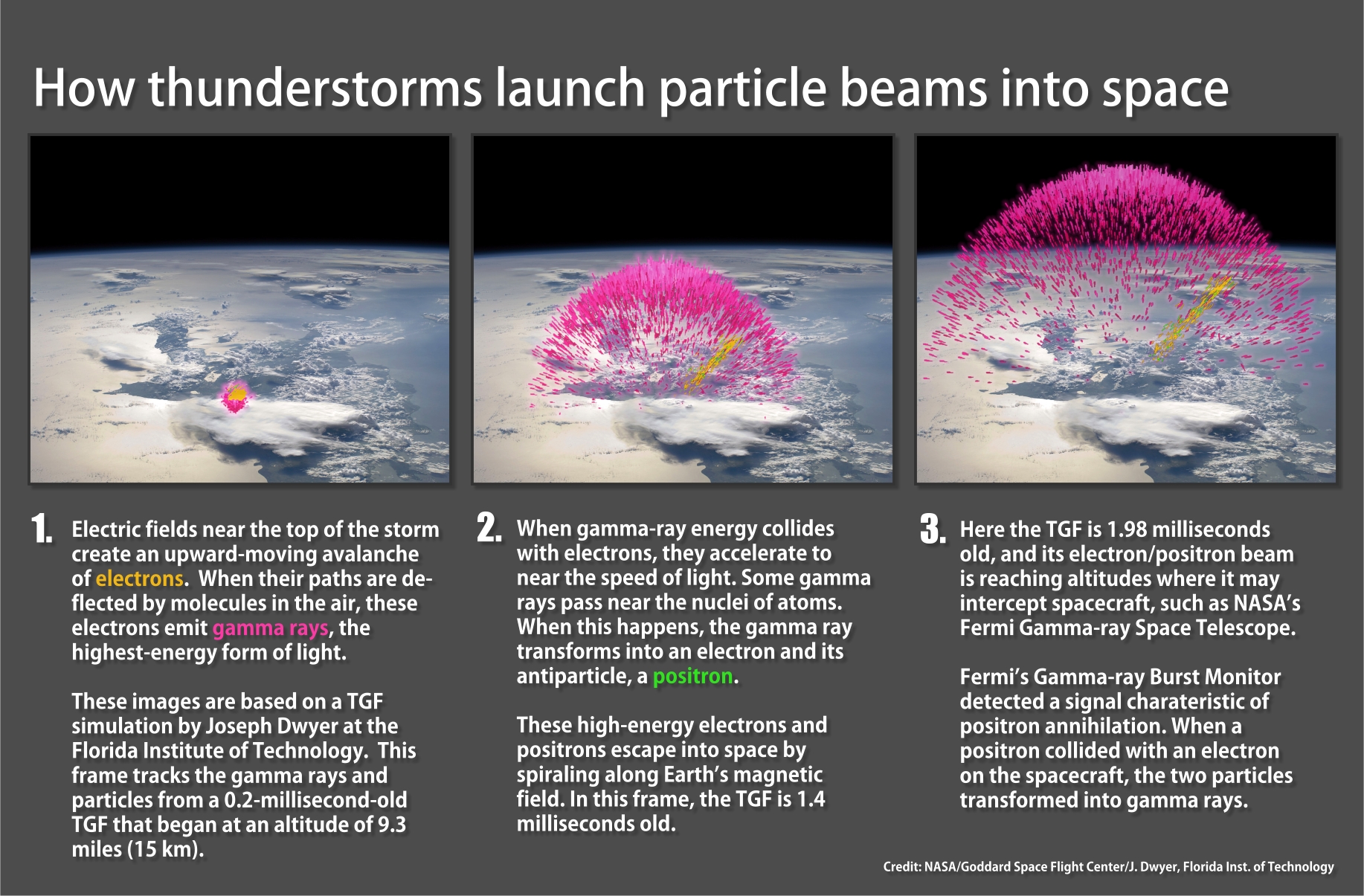Scientists now think that most TGFs produce particle beams and antimatter.
The Fermi spacecraft is designed to monitor gamma rays, the highest energy form of light. When antimatter striking Fermi collides with a particle of normal matter, both particles immediately are annihilated and transformed into gamma rays. The satellite's burst monitor has detected gamma rays with energies of 511,000 electron volts, a signal indicating an electron has met its antimatter counterpart, a positron.
Interactions with matter can produce gamma rays and vice versa. So-called "bremsstrahlung" gamma rays result when high-energy electrons traveling close to the speed of light become deflected by passing near an atom or molecule. In pair production, a gamma ray passing through the electron shell of an atom transforms into two particles: an electron and its antimatter opposite, a positron. Credit: NASA
Although the gamma-ray burst monitor is designed to observe high-energy events in the universe, it's also providing valuable insights into this strange local phenomenon. The instrument constantly monitors the entire celestial sky above and the Earth below. The GBM team has identified 130 terrestrial gamma-ray flashes since Fermi's launch in 2008.
The spacecraft was located immediately above a thunderstorm for most of the observed terrestrial gamma-ray flashes. But, in four cases, storms were far from Fermi. In addition, lightning-generated radio signals detected by a global monitoring network indicated the only lightning at the time was hundreds or more miles away. During one flash, which occurred on Dec. 14, 2009, Fermi was located over Egypt. But the active storm was in Zambia, some 4,500 kilometers (2,800 miles) to the south. The distant storm was below Fermi's horizon, so any gamma rays it produced could not have been detected.

CLICK IMAGE FOR FULL SIZE. How thunderstorms launch particle beams into space. Credit: NASA
"Even though Fermi couldn't see the storm, the spacecraft nevertheless was magnetically connected to it," said Joseph Dwyer at the Florida Institute of Technology in Melbourne, Florida, a coauthor on the scientific paper. "The TGF produced high-speed electrons and positrons, which
then rode up Earth's magnetic field to strike the spacecraft."
The beam continued past Fermi, reached a location, known as a mirror oint, where its motion was reversed, and then hit the spacecraft a second time just 23 milliseconds later. Each time, positrons in the beam collided with electrons in the spacecraft. The particles annihilated each other, emitting gamma rays detected by Fermi's GBM instrument.
Scientists long have suspected that terrestrial gamma-ray flashes arise from the strong electric fields near the tops of thunderstorms. Under the right conditions, they say, the field becomes strong enough that it drives an upward avalanche of electrons. Reaching speeds nearly as fast as light, the high-energy electrons give off gamma rays when they're deflected by air molecules. Normally, these gamma rays are detected as a terrestrial gamma-ray flash.
Diagram showing the behavior and composition of TGF emissions. Credit: NASA/Goddard Space Flight Center/J. Dwyer/Florida Inst. of Technology
But the cascading electrons produce so many gamma rays that they blast electrons and positrons clear out of the atmosphere. This happens when the gamma-ray energy transforms into a pair of particles: an electron and a positron. It's these particles that reach Fermi's orbit.
The detection of positrons shows many high-energy particles are being ejected from the atmosphere. In fact, scientists now think that all terrestrial gamma-ray flashes emit electron/positron beams.
"These signals are the first direct evidence that thunderstorms make antimatter particle beams," said Michael Briggs, a member of Fermi's Gamma-ray Burst Monitor (GBM) team at the University of Alabama in Huntsville (UAH).





Comments